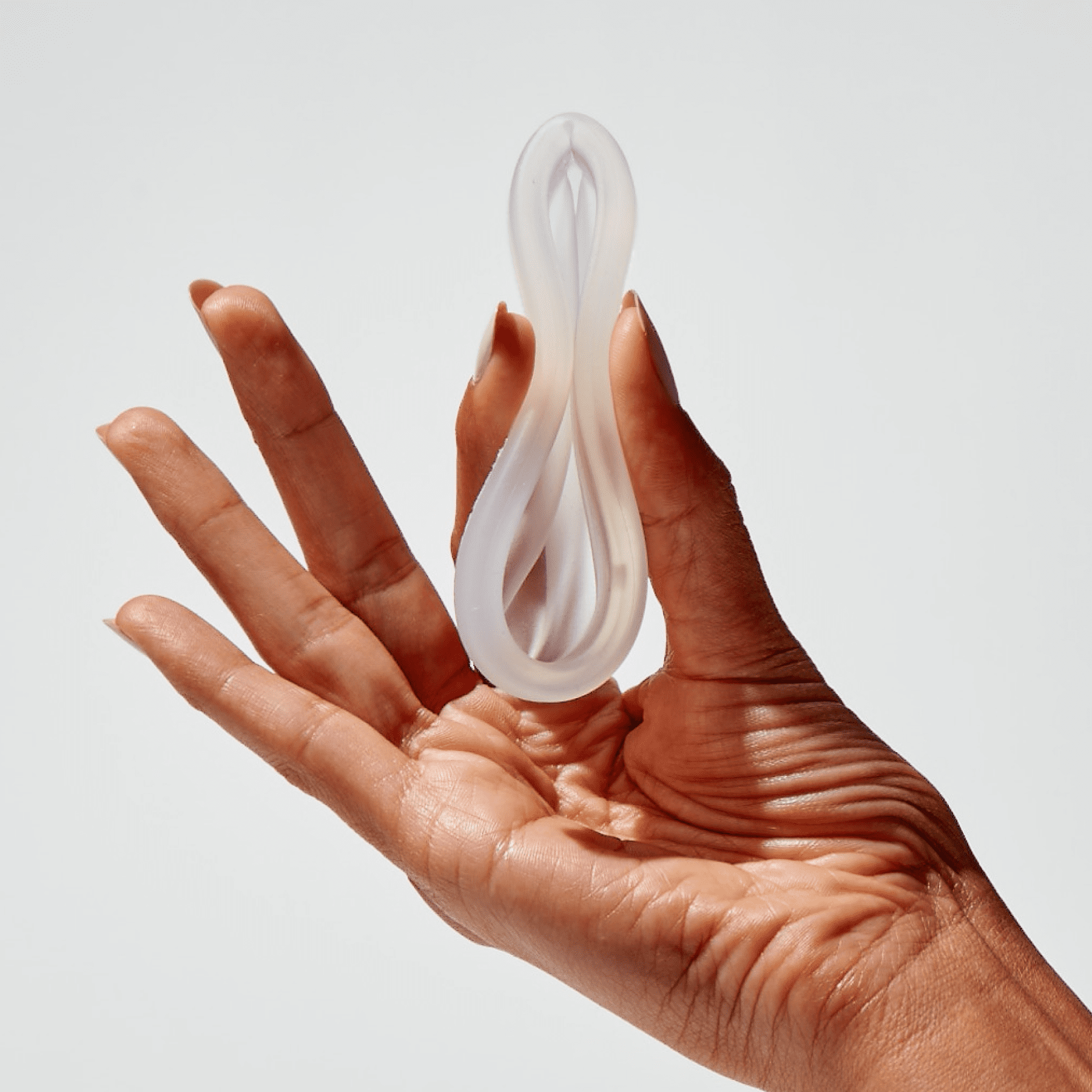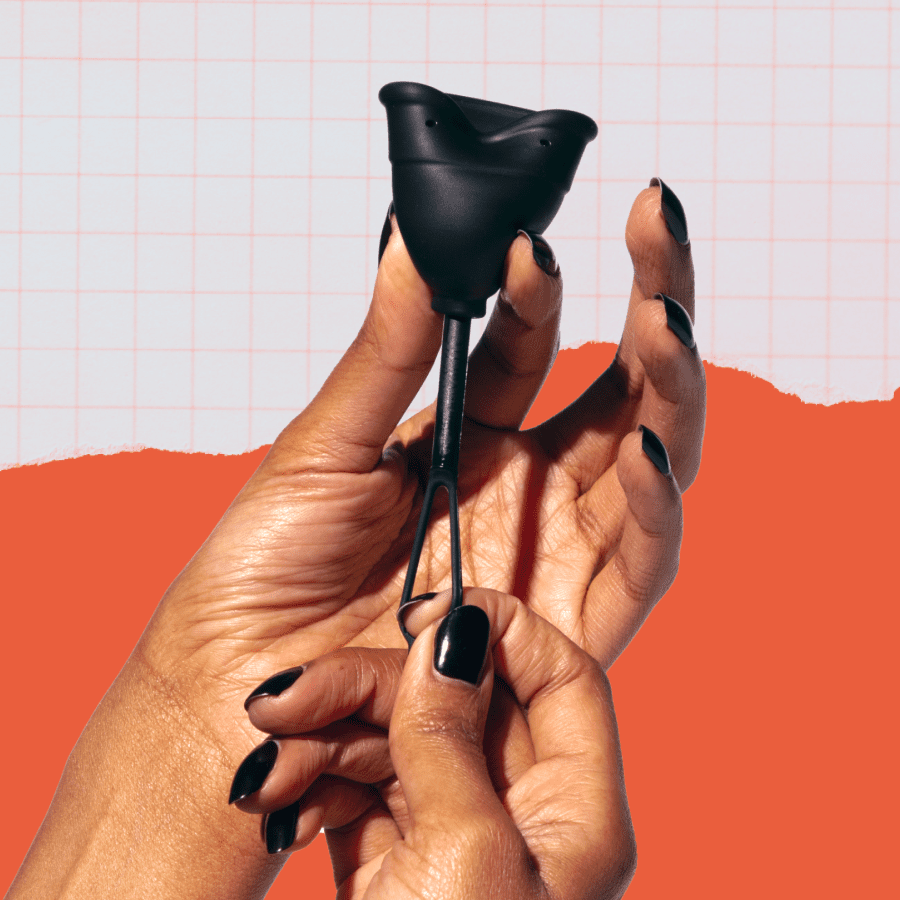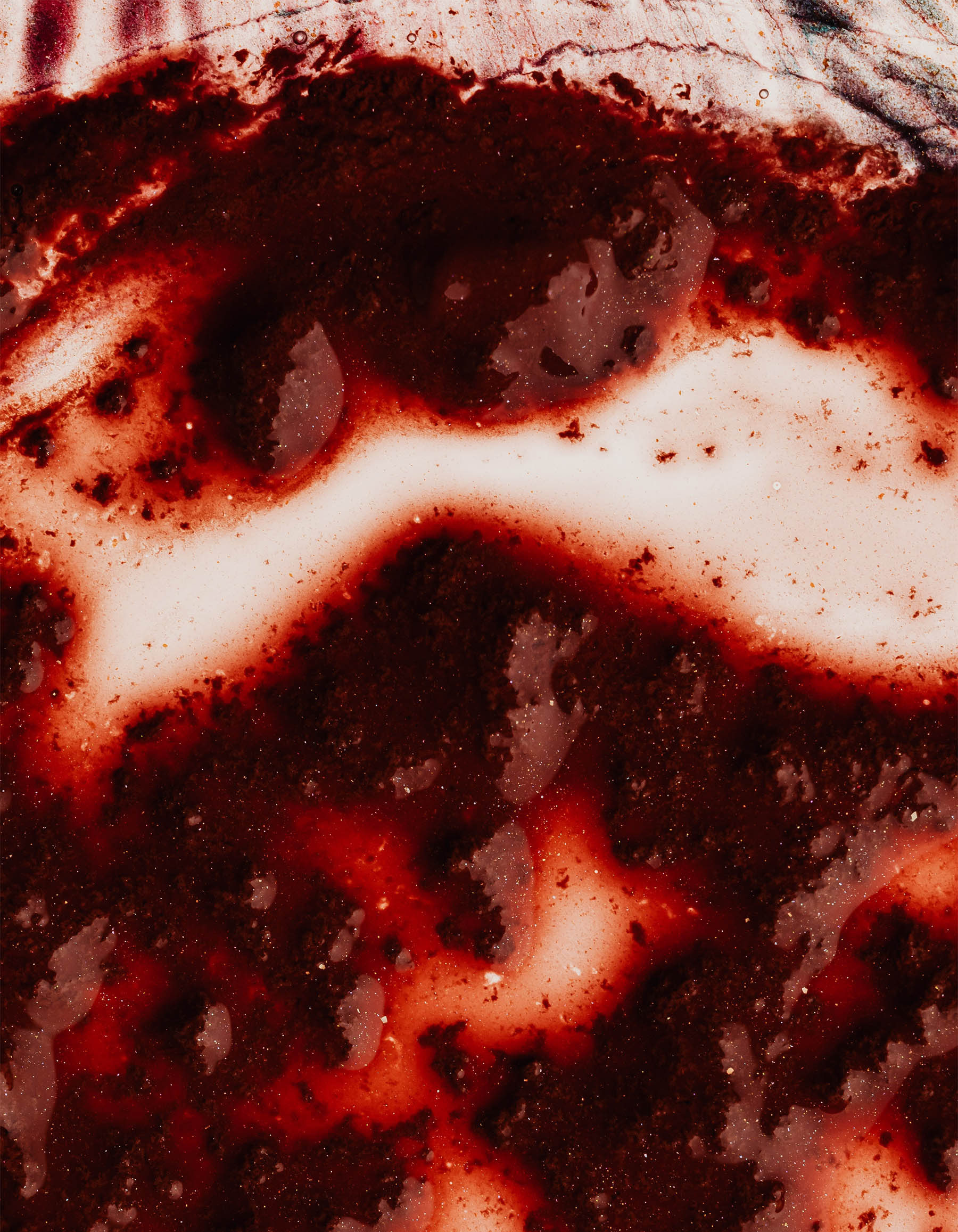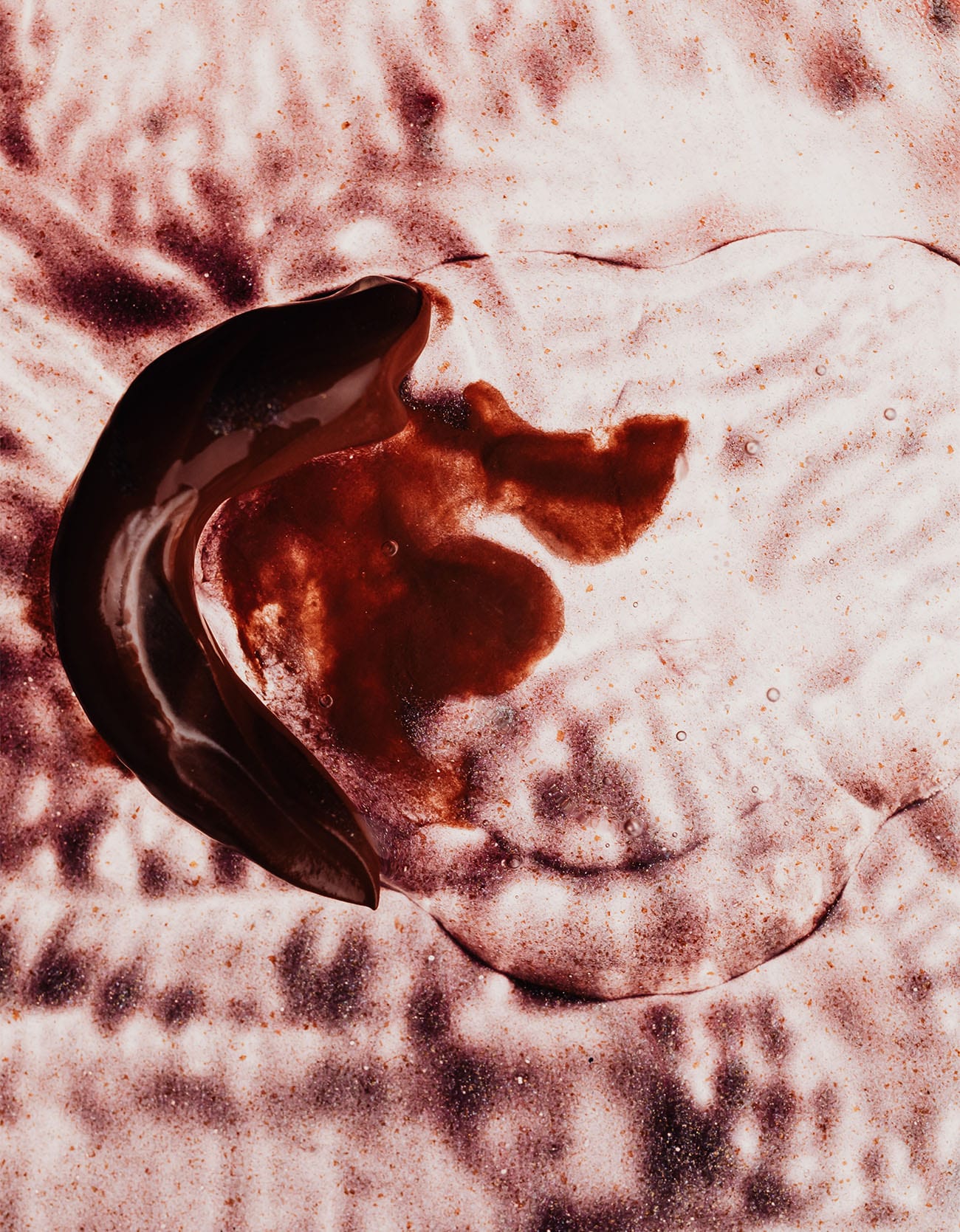Why is my period blood brown? All about period blood colors
Periods are a spectrum…we all have slightly different ones, whether that’s in length, flow, or regularity, among other things. But did you know that periods even differ on the color spectrum? That’s right—menstrual bleeding can come in lots of colors besides the classic bright red, rounding out that ROYGBIV wheel we all know and love.
Some of these colors are to be expected. Others are off the beaten path and could warrant a little detective work. This article will take you through it all, from the meaning of different colors on that blood color wheel to the ideal color of discharge, to when those colors might indicate something going on with your health.
As always, we encourage you to talk to a healthcare provider if you’re ever concerned about a noticeable change in your menstrual flow or period symptoms. But here’s a little bit of scientific intel to get you started:
Back to basics: Discharge vs. period blood
What’s the deal with vaginal discharge—a.k.a. cervical mucus?
Let’s start with the basics. Vaginal discharge is a term often tossed around when describing the different fluids that can show up on your underwear or liners. The name is a bit of a misnomer, however; in reality, vaginal discharge is composed of cells that can come from your vagina as well as your cervix, mixed in with a healthy dose of mucus, bacteria, and good ol’ H2O.1
Discharge: what’s normal and what to expect
Most people AFABAFAB stands for “assigned female at birth.” of reproductive age have a little bit of discharge every day. Because “a little bit” can mean different things to different people …let’s quantify that:
A normal, physiologic amount of vaginal discharge is about one-half to one full teaspoon of vaginal discharge per day. Another way to picture this is about a thumbnail’s size of discharge.
Your discharge should be clear or white in color. It can be thin and egg white-like or thicker and creamier depending on the stage of your cycle, hormone levels, and other factors—but it should not have a noticeably unpleasant odor.
You may notice that your discharge increases in quantity during these times:
- Around ovulation, or the two weeks before menstruation
- When using hormonal birth control pills or other hormonal methods
- When pregnant
Sometimes, your discharge might change in color from its usual clear or white—and that could signify a problem (more on unusual discharge colors below).
And what about period blood?
Period blood, on the other hand, looks like… well… blood. But technically, it isn’t just that. Menstrual fluid is typically made up of a mixture of cervical mucus (discharge), vaginal secretions, blood, and endometrial tissue. The proportion of those elements in your menstruation’s “recipe” is part of what dictates its color and consistency.
Unlike discharge, it’s normal for your period to have a distinct smell. That smell is thanks to bacteria: Did you know that there’s a microscopic ecosystem of bacteria that make their home in your vagina? Normally, those bacteria (mostly “good” bacteria, i.e. lactobacilli) don’t smell like much of anything. But when they get mixed in with menstrual fluid, it produces an odor.
The scent of period blood might change a bit from one cycle to the next based on the amount of bacteria hanging out down there. Usually, a bit of period odor is nothing to worry about, but if something smells seriously rotten, see a doctor to rule out Bacterial Vaginosis (BV) or another infection.
Period blood colors: what the colors in your underwear actually mean
So, what period blood colors – and discharge colors – are normal? Can a color alone point to something going on with your overall health? Sometimes yes, sometimes no: We’ve got all the answers below.2
What causes the color of your period blood?
The color of your period blood can vary based on factors such as the amount of oxygen present, the length of time it takes to leave your body, and the pH level. Brown period is usually older blood that has taken longer to exit the body.
Bright red period blood


Pop quiz: What color should your menstrual blood be? Not a trick question, folks. The answer is red.
This makes sense, as your uterus is shedding off the layers it has built up through the follicular phase. The sloughing off of the endometrium turns into menstrual fluid: A mixture of endometrial tissue and cells, blood, and whatever else it finds its way into the vaginal canal. Mostly, menstrual fluid will appear red in color thanks to the heme in red blood cells.
Bright red bleeding is ok. Dark red period blood is A-OK, too. Usually, the darker it is, the longer it has been waiting to be shed. A darker red color might also be seen in menstrual clots.
Pink period blood or pink discharge


Have you ever noticed that your period comes in a rosy pink color? Or that you see shades of pink in those early days leading up to your period? This may be because your period is getting mixed with vaginal discharge. If you recall from preschool, red plus white = pink.
So long as this gives way to the normal red color for the rest of your period, it should be par for the course. However, if this rosy pink blood sustains into the rest of your period, or if it shows up at random times or across multiple cycles, it’s always good to bring it up with a healthcare provider to make sure nothing’s going awry behind the scenes.
This is especially true if you’re in your late forties or older and have already completed menopause. In this age range, any pink or brown discharge could be a sign of a precancerous disorder, according to the Merck Manual.3
Blue or purple period blood (often dark bluish or purplish-red)
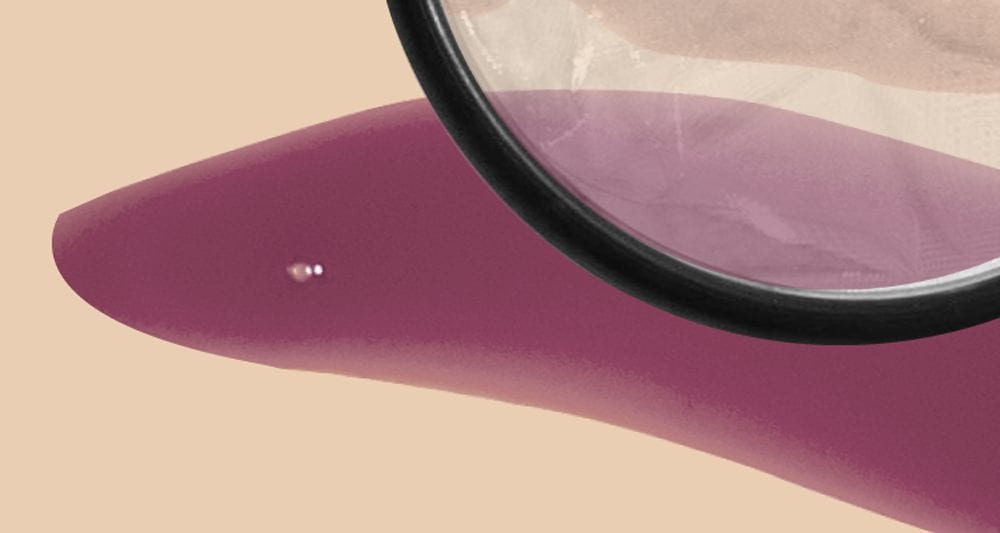

Just to level-set here, it’s unlikely that your menstrual blood would ever be obviously purple in color: That would be strange, and probably a good time to reach out to a healthcare provider. The more common scenario is that there are little splotches of blue-purple that come in the shape of clots.
Blood clots during your period are little clusters of tissue from your uterus that weren’t fully broken down during the latter phases of the menstrual cycle; they will clump together and pass just like that. Quite often, they end up looking more blue-purple just as a result of their components.
It is relatively normal to pass a couple clots throughout your period, especially on the heavy bleeding days. But if those clots are accompanied by severe pelvic pain, are larger than a quarter, or happen on multiple days or over multiple cycles, then reach out to a provider ASAP.
Heavy menstrual bleeding can also be a cause for concern if the blood appears blue or purple. This could indicate a condition called von Willebrand disease, which affects the blood’s ability to clot properly. It’s important to discuss this with a healthcare provider to determine the underlying cause and receive appropriate treatment.
In some cases, certain medications or hormonal imbalances can also contribute to color changes in period blood. For example, taking anticoagulant medications may cause the blood to appear darker or have a bluish tinge. Similarly, hormonal changes during perimenopause or certain birth control methods can affect the consistency and color of menstrual blood.
If your period blood itself is, sans clots, purple or purplish-red, some Chinese medicine practitioners associate this with conditions like fibroids or endometriosis.4 And there’s anecdotal evidence from naturopathic doctors that purplish blood could point to higher-than-normal estrogen levels.5 Keep in mind that neither of these assumptions are scientifically proven: Always trust your licensed healthcare provider to decide whether or not there’s a cause for concern (and don’t simply go off something you read on the Internet).
Brown Period Blood
If you’re asking yourself, why is my period blood brown? It’s likely because…it’s old blood. Brown period blood is normal!
There are many reasons why you might see brown spots or brown vaginal discharge after your period. For one, by the end of your period, any sloughed-off tissue that has been sitting up in your uterus may look a little different than it did on cycle day one. Women in perimenopause can also experience brown period blood due to hormonal changes and fluctuations.
It’s important to note that while brown period blood is generally nothing to worry about. If you experience any unusual symptoms along with it, such as severe pain, foul odor, or prolonged bleeding, it is always advisable to consult with a healthcare professional.
Also, if you notice a brown blood flow during the first couple days of your period, or if it comes with a bunch of clots, then reach out to your healthcare provider. Dark brown bleeding at the beginning of your cycle could be a sign of a potential hormonal imbalance, among other things.
In some cases, brown period blood may be due to certain lifestyle factors or habits. For example, using certain types of contraception, such as an intrauterine device (IUD), can sometimes be the cause of brown discharge or spotting. Additionally, if you have recently started or stopped taking hormonal birth control, it can affect the color and consistency of your period.
- Hormonal Imbalances: Hormonal imbalances can also contribute to brown menstrual blood. These imbalances can be caused by various factors, such as polycystic ovary syndrome (PCOS), thyroid disorders, or certain medications. If you suspect a hormonal imbalance, it is important to consult with your healthcare provider, who can help diagnose and treat the underlying cause.
- STI’s or other Infections: STIs (sexually transmitted infections) and other infections can also lead to brown period blood. Conditions such as pelvic inflammatory disease (PID) or cervicitis can cause inflammation and result in abnormal bleeding. If you suspect an infection, it is crucial to seek medical attention to receive a proper diagnosis and treatment. Most infections are easily treatable with medication; antibiotic treatment is typically the first course of action.
- Endometrial or Cervical Issues: Certain conditions affecting the endometrium (the lining of the uterus) or cervix can lead to – you guessed it – brown period blood. Examples include endometriosis, uterine fibroids, or cervical polyps. These conditions may cause alterations in the color.
- Postpartum: If you have just gone through pregnancy, it’s not uncommon to experience brown period blood. This can result from the body shedding the remaining tissues and blood from the pregnancy. Lochia is the name of the bleeding that occurs during the postpartum phase. It is a common occurrence after childbirth. This can appear as pink, brown, or even reddish-brown discharge.
- Miscarriage or Ectopic pregnancy: If you have recently experienced a pregnancy loss or ectopic pregnancy, brown period blood may indicate that your body is expelling the remaining tissues from the pregnancy. It is important to reach out to your healthcare provider if you suspect a miscarriage or ectopic pregnancy, as they can provide guidance and support through this difficult time.
- Implantation Bleeding: Implantation bleeding is another potential cause of brown period blood. This early sign of pregnancy occurs when a fertilized egg implants itself into the uterine lining, causing some light bleeding. The color of the blood may appear brown due to the small amount and older age of the blood being discharged.
Rust-colored or orange period blood


Here we’re starting to get into the subjective part of the color wheel—one person’s rust might be another person’s red, brown, or tangerine. But in general, orange-ish or rust-colored period blood isn’t always abnormal, but it may be a sign of something more concerning going on.
If you notice other symptoms along with your orange period blood or discharge—like vaginal itchiness, pain, burning, or redness—then definitely see a provider ASAP to get checked out.
Black Period Blood: Why is my period blood black?


If it’s black, then that means that it is very, very old blood. This occurs when the blood has been in your uterus for an extended period of time before being expelled. It can happen if you have a slow flow or if the blood takes longer to exit your body.
If you experience black blood at the end of your period, then it’s probably fine, but if it’s popping up sooner or in repeated cycles, then…yes, we’re going to say it again…reach out to a provider. They can offer professional guidance and ensure everything is alright. Remember, it’s important to listen to your body and seek professional advice whenever necessary.
White discharge
A “normal” vaginal discharge is clear or whitish in color, non-odorous, and can show up daily, usually increasing during certain times of the cycle. Anything different could hint at an imbalance in vaginal pH, possible infection, hormonal changes, or something else.
If you have white discharge that’s thick, clumpy, cottage cheese-like, or has a definite scent, you may have a yeast infection—especially if things are getting itchy. When in doubt, talk to your provider.
Yellow-green or yellow vaginal discharge
According to the NHS, yellow-green or yellow vaginal discharge could be a sign of an infection such as trichomoniasis—a common sexually transmitted infection (STI) that’s actually caused by a parasite (rather than bad bacteria).6 It may have an unusual scent and come along with itching or burning, soreness, or pain when urinating. If this sounds like you, get in touch with a provider.
Greenish or yellow discharge after menopause might also indicate Desquamative inflammatory vaginitis (DIV), which is related to vaginal atrophy—this happens when your vaginal walls have thinned out due to the drop in estrogen and may have become inflamed. Your provider can prescribe a topical cream to help with DIV.7
Gray discharge


Again, this is super subjective, but if it looks gray to you, or is subjectively different from your run-of-the-mill cervical or menstrual fluid, then it could be a sign of BV or another vaginal infection. The likelihood increases, once again, with symptoms like vaginal itching, pain, redness, irritation, or dyspareunia (pain during sexual intercourse).
Why is my discharge brown?
Additionally, if you have irregular bleeding or spotting between periods, it’s not uncommon to see brown discharge. This can be caused by various factors such as stress, changes in birth control, or infection. A foreign body (such as a tampon, condom, sex toy, or contraceptive ring) can also lead to an infection and cause brown discharge. Some STI’s such as chlamydia or gonorrhea, can also cause brown discharge, so it’s important to get tested if you’re experiencing any concerning symptoms.
If you experience brown discharge accompanied by other symptoms such as severe pain, unusual odor, or itching, it’s always a good idea to consult with your healthcare provider. They can help determine if there is an underlying issue causing the brown discharge.
Brown discharge before period
A few different things can cause brown discharge before your period. One possibility is old blood that didn’t fully shed during your last period. Sometimes, the blood takes longer to exit your body and may appear brown instead of red. Another possibility is breakthrough bleeding, which can occur when there are hormonal fluctuations in your body. This can happen when starting or stopping birth control pills or due to other factors affecting your hormone levels.
However, if you experience prolonged or heavy brown discharge before your period, it’s always a good idea to consult with your healthcare provider. They can help determine the underlying cause and provide appropriate treatment if needed.
Brown discharge after period
If you experience brown discharge after your period, it could be a sign that your body is simply eliminating any remaining blood from your uterus. This is usually nothing to worry about and is considered normal. Again, if you experience persistent or heavy brown discharge after your period, it’s advisable to consult with your healthcare provider. They can evaluate your symptoms and rule out any underlying issues.
In some cases, brown discharge may also occur as a result of an infection or hormonal imbalance. If you notice accompanying symptoms such as itching, odor, pain, or changes in your menstrual cycle, it’s important to seek medical advice for further evaluation.
Warning signs: Unusual menstrual bleeding or discharge
Any weirdness in your discharge or menstruation that catches you by surprise is worth mentioning to a healthcare provider or OB/GYN. If it’s not normal to YOU, it could point to a problem—and even if it ends up being nothing at all, you’ll feel better by finding out.
Don’t forget to factor in the color of your underwear. Black underwear might make perfectly normal white discharge look a little gray. But don’t disregard other signs and symptoms you’re experiencing.
Here is a list of warning signs to watch for. If they show up on their own or with changes in period blood or discharge color, then get in touch with a healthcare professional.
- Abnormal vaginal discharge for you, whether that is a change in color, thickness or consistency, or smell [Quick note here: normal discharge should be largely odorless. If it does smell, then you should get in touch with a healthcare provider for more information.]
- Pelvic pain at rest or during sex
- Vaginal itchiness, redness, or irritation
- Flank pain
- Changes in your urine, such as blood in the urine or pain with urination
- Passing multiple clots during one period, especially foul-smelling clots or large clots bigger than the size of a quarter
- Spotting or vaginal bleeding between periods
This is not an exhaustive list—so, even if you’re having symptoms that seem totally unrelated, make sure to mention them to your provider.
Key takeaways
Period blood can come in an array of colors, and that color can give you a hint to what’s happening beneath the surface. So can your cervical mucus (more commonly known as discharge). Keep in mind that up to a teaspoon of vaginal discharge per day is normal, and that it should be either clear or white and more or less odorless.
During your period, the mainstay colors will be pink to bright red blood, with potentially some darker colors at the end of the period from the older tissue. Gray, blue-purple, and orange or rust colors in your underwear are more likely to be a cause for concern—especially if they come with other symptoms.
Always reach out to a healthcare provider or OB/GYN if anything doesn’t feel right. Depending on your age and symptoms, your doctor may want to routinely test you for cervical cancer, monitor ovarian cysts or discard other conditions. So, get your yearly ob-gyn check-ups and make sure there’s nothing else going on!
This article is informational only and is not offered as medical advice, nor does it substitute for a consultation with your physician. If you have any gynecological/medical concerns or conditions, please consult your physician.
© 2025 The Flex Company. All Rights Reserved.
- Anderson, M. R., Klink, K., & Cohrssen, A. (2004). Evaluation of vaginal complaints. JAMA, 291(11), 1368–1379.[↩]
- Kollikonda, S. (2020, September 28). What does the color of your period mean? Cleveland Clinic. Retrieved May 05, 2021, from https://health.clevelandclinic.org/what-does-the-color-of-your-period-mean/[↩]
- Vaginal discharge. (2020, April). Merck Manuals Consumer Version. https://www.merckmanuals.com/home/women-s-health-issues/symptoms-of-gynecologic-disorders/vaginal-discharge[↩]
- What the colour of your period tells about your health and fertility. (2020, June 16). Thomson Chinese Medicine. https://www.thomsontcm.sg/articles/what-the-colour-of-your-period-tells-about-your-health-and-fertility/[↩]
- Period blood colour: What does yours mean? (2021, January 29). Nourished Natural Health. https://nourishednaturalhealth.com/nutrition-guides/period-blood-colour[↩]
- Vaginal discharge. (2017, October 18). NHS.uk. https://www.nhs.uk/conditions/vaginal-discharge/[↩]
- How to decode your vaginal discharge. (2021, March 9). Health Essentials from Cleveland Clinic. https://health.clevelandclinic.org/vaginal-discharge-mean/[↩]




